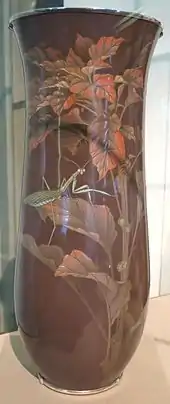Hattori Tadasaburō
Hattori Tadasaburō (服部唯三郎) was a Japanese cloisonné artist from Nagoya.

Cloisonné vase with design of praying mantis amid foliage by Hattori Tadasaburō, first quarter of 20th century (private collection)
Along with Kawade Shibatarō, Tadasaburō developed the moriage or "piling up" technique which places layers of enamel upon each other to create a three-dimensional effect.[1]
Many of his works are held in collections such as the Victoria & Albert Museum[2] and the Khalili Collection of Japanese Art.[3]
See also
References
- Khalili, Nasser D. "In a way all my work is founded on Japanese art …". guimet.fr. Guimet Museum.
- https://collections.vam.ac.uk/item/O1193014/pair-of-vases-hattori-tadasaburo/
- Earle, Joe (1999). Splendors of Meiji : treasures of imperial Japan : masterpieces from the Khalili Collection. St. Petersburg, Fla.: Broughton International Inc. p. 275. ISBN 1874780137. OCLC 42476594.
External links
![]() Media related to Hattori Tadasaburō at Wikimedia Commons
Media related to Hattori Tadasaburō at Wikimedia Commons
This article is issued from Wikipedia. The text is licensed under Creative Commons - Attribution - Sharealike. Additional terms may apply for the media files.